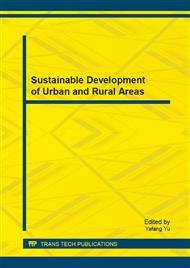[1]
L.H. Miao: Research Review of Xixi Wetland in Hangzhou. Journal of Anhui Agri. Sci., 37 (2009)5043-5044. (in Chinese).
Google Scholar
[2]
G. Sun and D.A. Austin: Mass balance study on nitrification and deammonification in vertical flow constructed wetlands treating landfill leachate. Water Science and Technology, 56(2007)117-123.
DOI: 10.2166/wst.2007.503
Google Scholar
[3]
L.P. Xu and H.C. Liu: Aquatic plant resources investigation in Xixi national wetland park in Hangzhou[J]. Acta Agriculturae Zhejiangensis, 5(2008)555-558. (in Chinese).
Google Scholar
[4]
Q. Shen, C.Y. Huang and Y.P. Jiang: Comparison of vascular plant species diversities between Hangzhou Xixi and Shaoxing Jinghu national wetland park, East China. Journal of Wuhan Botanical Research, 26(2008)385-390. (in Chinese).
Google Scholar
[5]
J. Zhang, W. Huang and L.H. Sang. The water purification ability of plants on floating bed and its influencing factors. Journal of Yangtze River Scientific Research Institute, 28(2011)39-42. (in Chinese).
Google Scholar
[6]
W. Song, Q. Zhou, Y.L. Wang, et al.: Comparison on adsorbing capacity of several kinds of plants and their application on foating rafts. Jiangsu agricultural sciences, 5(2010)474-477. (in Chinese).
Google Scholar
[7]
X.R. Mao and J.B. Zhou: Water purification capacity of several aquatic plants used in ecological floating bed. Journal of Zhejiang agricultural science, 1(2011)157-159. (in Chinese).
Google Scholar
[8]
GB 11914-89: Water quality-Determinotion of the chemical oxygen demand-Dichromate method[S].
Google Scholar
[9]
GB 11894-89, Water quality-Determination of total nitrogen-Alkaline potassium persiflage digestion-UV spectrophotometric method[S].
Google Scholar
[10]
GB 11893-89, Water quality-Determination of total phosphorus-Ammonium molybdate spectrophotometric method[S].
Google Scholar
[11]
A.K. Kivaisi: The potential for constructed wetlands for wastewater treatment and reuse in developing countries: a review[J]. Ecology engineering, 16(2001)545-560.
DOI: 10.1016/s0925-8574(00)00113-0
Google Scholar
[12]
K.R. Reddy and T.A. Debusk: State of the all utilization of aquatic plants in water pollution control[J]. Water Science and Technology, 19(1987): 61-79.
DOI: 10.2166/wst.1987.0098
Google Scholar
[13]
M. Greenway and A. Woolley: Changes in plant biomass and nutrient moral over 3 years in a constructed wetland in Cairns, Australia[J]. Water Science and Technology, 200l, 44(2001)303-310.
DOI: 10.2166/wst.2001.0844
Google Scholar


